Has a gas stove become available to everyone, both in an apartment and in a private house? it remains only right choose gas hose... A couple of decades ago, they were all connected to a common gas pipeline using a steel pipe. This caused some inconvenience to the housewives when it was necessary to clean the floor or wall behind the stove or move it during the renovation process. Nowadays, a similar problem is successfully solved flexible gas hoses of various lengths and qualities.
There are 4 types of hoses for a gas stove. Choosing a gas hose
The first known type of hose for a gas stove is an oxygen one. It was very common in Soviet times, but is rarely used now, because more reliable modern hoses have appeared.

The second most popular is a rubber-fabric gas hose. Its main advantages are price, flexibility and softness. Rubber products do not conduct electricity. However, such a hose has no protection against sudden changes in temperature and has a short service life.

The third type is a rubber hose with a metal sheath. You can distinguish between gas and water hoses by the yellow line along the entire surface. Water supply hoses are marked in red or blue. The metal braiding is made of steel wire. And the core of this type of hose is made of special polymer materials or thick rubber. It depends on the manufacturer. The braid on such a hose protects it from mechanical damage. Gas hose has a high degree of flexibility. Withstands temperatures up to 50 degrees.

Before buying, it is important to decide on the length of the hose. The gas hose must not be taut; it may rupture. Choose a hose slightly longer than the distance from the stove to the gas riser, consider rearranging it in the future or replacing the floor covering when the gas stove has to be lifted.
Gas hose regulations
Right now in different countries different standards for the use of gas hoses. For example, in Ukraine, all types of hoses are prohibited, except for a gas hose in a metal sheath. In Russia there are no restrictions on the length of the gas hose, but in European countries there is this restriction and it is 2 meters. In Ukraine, the length of the gas hose should not exceed 2 meters for appliances and 0.5 for a meter.
A gas hose, it would seem, what kind of mystery can there be in this simplest product? Came to any hardware store, took it and go to the checkout. However, have you ever wondered what is the difference between a gas hose for a gas stove and a gas hose for? And most importantly, on the shelves of large retail chains such as Leroy Merlin or Maxidom, this product is simply presented in a huge assortment. Inevitably, the question arises: which gas hose is better to buy? On one tray there is a pvc gas hose reinforced with polyester thread, on the other there is a bellows-type gas hose, and even lower there is a rubber sleeve in general, and how not to get confused?
More recently, just a couple of decades ago, you would not have worried about how to connect a gas stove. All gas household appliances, after purchase, “tightly” and reliably were connected, as a rule, by the master of their nearest housing office using a steel pipe. Of course, they didn't even think about aesthetics or design. There was only one task - to start using the new device as soon as possible.
Accession steel pipe undoubtedly has a number of advantages. Requirements such as strength, reliability and safety are 100% guaranteed. Here is just a small inconvenience, the hostess will most likely not be able to wash the floor under the stove for the next twenty years. And the kitchen furniture cannot be found in the required size, so 20 centimeters remain on each side of the stove, but it is not possible to move it. Finally, such problems are a thing of the past, and there is no shortage in the domestic economic market for a long time, and flexible gas supply lines are offered in a large assortment.
Choosing a gas hose for a stove or boiler is a very serious step. The lives of many people depend on its strength, reliability and safety. Often, the result of an illiterate connection of a stove or gas water heater to communications is an explosion. For flexible supply of natural gas, only special gas hoses are used. It is strictly forbidden to use plumbing for this purpose.
Of course, it is better to call a specialist who will provide a professional connection and give a guarantee. Each of us has seen in the news what explosions of household gas lead to, including as a result of unqualified connections of household gas appliances. We know from childhood that you can't joke with gas. However, a modern gas hose allows you to make the connection yourself. Adhering to elementary safety rules, any adult man can perform a similar procedure.
So, let's go to the store. Let's see what the seller offers there, which flexible gas hose to choose and buy for a gas stove? It turns out that there are three main types of gas hoses used in everyday life:
- - rubber-fabric;
- - rubber reinforced;
- - bellows.
Rubber gas hose.
The softest of all types of hoses are rubber hoses reinforced with textile thread. They have long earned a reputation for being an unpretentious compound, and are often found in the economy of the zealous homeowner. Simple installation work, inexpensive cost, flexible properties and functionality are attractive qualities that determine the popularity. On the shelves, there are always options with different lengths and diameters.
Rubber is one of the best dielectric materials. They are used to supply liquefied gas to household appliances from gas cylinders and are used in summer cottages and in private houses. This method of flexible gas supply is the simplest and cheapest, but also most dangerous.
The big disadvantage is that over time, cracks form in the rubber, leading to gas leakage. The only place where the use of this type of flexible hose is permissible is gas cylinders in the private sector. Among other things, the products lack the necessary rigidity.
It is not recommended to use rubber hoses for more than two years, but in practice they last much longer.However, modern rubber hoses are made with the inclusion of elastic components that allow you to use the product for up to 5 years.
Reinforced gas hose.
The most common are rubber reinforced sleeves that look like water hoses. Outside, they are braided with steel threads. Although they are called rubber, they contain a polymer material inside. It is easiest to distinguish a gas type of a hose from a water hose by the color of the threads woven into the outer braid, they should be yellow.

Braided hoses are inexpensive and easy to use, but some European countries have banned their use. In our country, gas workers also recommend gradually abandoning them or operating them with precautions.
The plastic hose inside is subject to the same degradation and destruction as rubber. In addition, steel is a good conductor of electric current, so the connection must be made with the obligatory use of dielectric gaskets.
Stainless steel bellows gas hose.
Bellows type hoses are the only ones permitted by gas services for household gas appliances. What is a bellows? It is a corrugated, strong and dense shell that retains its properties when exposed to temperature, pressure and severe mechanical stress.
The bellows takes its name from the English. branded Sylphon. There are single and multi-layer types, made from both metallic and non-metallic materials. The casing serves as a barrier and gives the product increased safety.
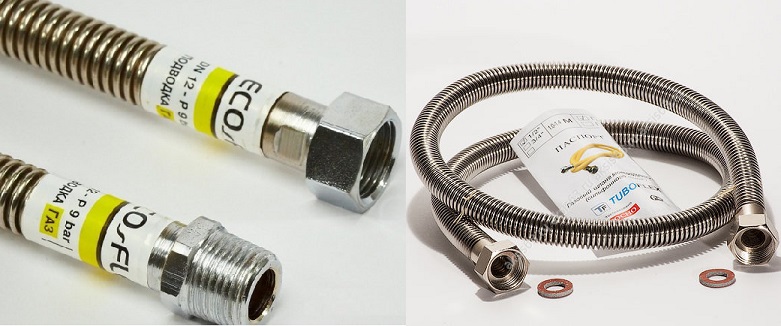
Bellows flexible sleeves are made of stainless steel. They are of two types. The first one in a metal braid without insulation, this type is suitable for ordinary stoves with traditional ignition from matches. If you have a modern gas stove equipped with an electric ignition and has a connection to the electrical network, then you should not bother yourself with the search for a dielectric gasket.
It is easier to turn your attention to the second type with a yellow polymer coating, which is a reliable electrical insulation. Such protection is especially relevant for gas stoves equipped with various electrical parts - electric ignition, lighting, electric grill. The polymer coating is durable, strong, reliable and guarantees absolute electrical insulation.
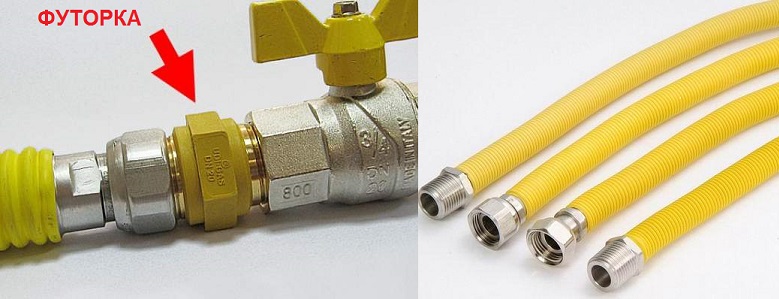
For uniform gas supply, an internal hose diameter of at least 10 mm is recommended. The benefits of using bellows hoses are undeniable. Specimens with a plastic coating, which guarantee excellent protection against various disasters, have proven themselves especially well.
The bellows sleeves have a service life of up to 30 years. Their only drawback is their high cost compared to other types of gas hoses, but as they say, safety is more expensive! Moreover, the increased cost in percentage terms will be negligible in comparison with the purchased gas equipment.
Gas bellows hose, advantages:
- The gas hose is manufactured in accordance with technical specifications and meets the regulatory provisions of GOST;
- The only one allowed for operation by government services;
- Component PVC coating provides the product with reliable protection. Polymers are highly resistant to aggressive media and mechanical shock.
- Gas supply lines often remain intact, subject to significant and sometimes critical loads;
- Manufacturers set a long service life for the product, more than 25 years;
- PVC protects against electrical influences of 1000 V and more.
- There are no standards for restrictions during operation.
How to choose the right gas hose
The main advice sounds quite trite: a gas hose without emergency consequences can be bought at any specialized store where you will be provided with a state-recognized certificate of conformity. Answering the question: which gas hose is better than bellows or rubber, opt for the first one. And of course, beware of cheap Chinese counterfeits or from other countries that do not care about the company's reputation. On the street market you can find quality fakes in which:
Gas hose made of very thin rubber, subject to rapid wear;
- many forgeries outward appearance completely indistinguishable from real ones, especially if you are a regular customer, and not a professional gas service employee
Do not forget to check for the presence of a yellow mark on the hose braid, it is this that indicates that you have a gas hose in your hands, and not a water supply line with a blue-red mark. It is not worth buying a gas hose with a "margin", first make the necessary measurements and add 20%, this length will be enough.
The manufacturer offers different lengths, but the most popular are one or two meter options. Standard diameters used in the home are 1/2 or 3/4 inches. The gas hose is equipped with two union nuts with an internal thread (American or in the common people mother-mother). The second type of hose, when at one end there is a nut, on the other there is a sleeve with an external thread - "female-father".
Connecting the gas hose to the stove
After purchasing a suitable version of the product, we are impatiently moving on to the measures for connecting the hose to a new stove. We find a fitting on the back of the plate, as a rule, with an external thread. This is the gas inlet. Plate manufacturers complete their products, depending on the model, with a straight or angled receiver.
If you got a device with a direct entrance, we recommend purchasing a brass corner with internal threads and the boundary wall into which the paranite gasket is inserted. Avoid kinking the hose during installation.
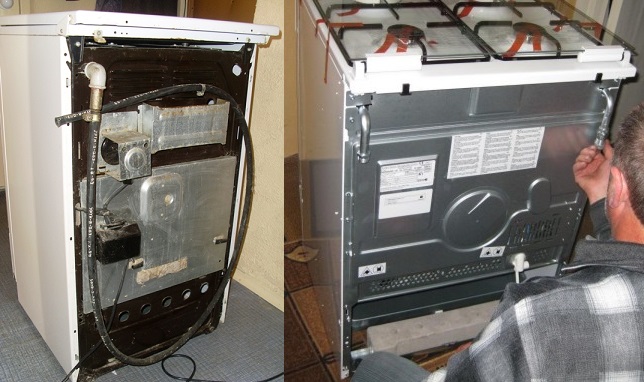
Imported slabs are sometimes sold with 3/8 or 3/4 inch outlet threads. There will be no tragedy if you in advance, additionally purchase a regular adapter “futorka” for proportional threads of your gas hose. In residential buildings gas riser usually laid in one of the corners of the kitchen. There is a branch for your use; a gas valve must be installed on it. We will screw or screw our gas hose onto it, depending on which thread the valve is equipped with.
The gas hose comes with two paronite gaskets as standard. Remember to use them during the connection, so it will be easier for you to ensure that there are no leaks. It is also advised to use a separately purchased pad with a fine mesh, the masters claim that it will help get rid of all sorts of dirt. But we leave this procedure to your discretion, since usually the gas comes in without mechanical inclusions.
The gas hose is screwed on with a wrench, but do not overdo it and do not squeeze out the paronite. After the work has been completed, it remains to carry out a mandatory check for a possible gas leak. It is enough to apply soap foam to the joints, the absence of air bubbles means that the work is done with high quality and the stove can be used. Bon Appetit!
Compliance with safety fundamentals
- The main requirement of the gas service is access to the supply line, so the flexible hose for the gas stove must be within reach;
- The presence of third-party connection of devices to the gas stove is not allowed;
- The gas hose must be kept clean, no embellishment is allowed, it must not be painted over, and other “improvements” in appearance must be made;
- The liner should have natural sagging. Pulling is fraught with a break in the hose, or gas leakage at the points of connection to the fittings;
- If you plan to move the hob before general cleaning, calculate in advance the required length of the gas hose. Be sure to close the ball valve before starting to move;
- Avoid strong bends and twists;
- It is necessary to protect the metal braid from condensation;
- Do not weld or solder the joint, use only the threaded splice method;
- Replace the old one with a new gas hose in a timely manner, in accordance with the service life established by the manufacturer.
We really hope that our review helped to determine and understand which gas hose for a gas stove is better to choose. Now you definitely will not "get lost" in the store, as you learned the specific features and differences of gas hoses from each other. Self-connection also does not take much time if you have the necessary tools.
However, please note that a number of manufacturers do not allow the owner of the equipment to do such work. One of the requirements is increasingly becoming the condition for the connection of devices by specialists of an authorized gas service. Otherwise, there is a risk of losing the warranty. Check in the operating instructions if you lose the warranty on the stove if you connect it yourself. If not, good luck!
We offer you an entertaining video review, where on channel 1 they recommend which gas hose is better to use at home:
In Soviet times, the connection of a gas stove to a gas pipeline was subject to more stringent regulations. They are the only possible option there was a connection using a rigid pipe. Gas was supplied to the stove metal pipe... For turns, corners and knees were used. And therefore it was impossible to move the stove, even a small wet cleaning was accompanied by difficulties.
Nowadays, in connection with the emergence of new materials, the use of flexible pipes is allowed. But, it is very important to follow all the rules and correctly connect the gas.
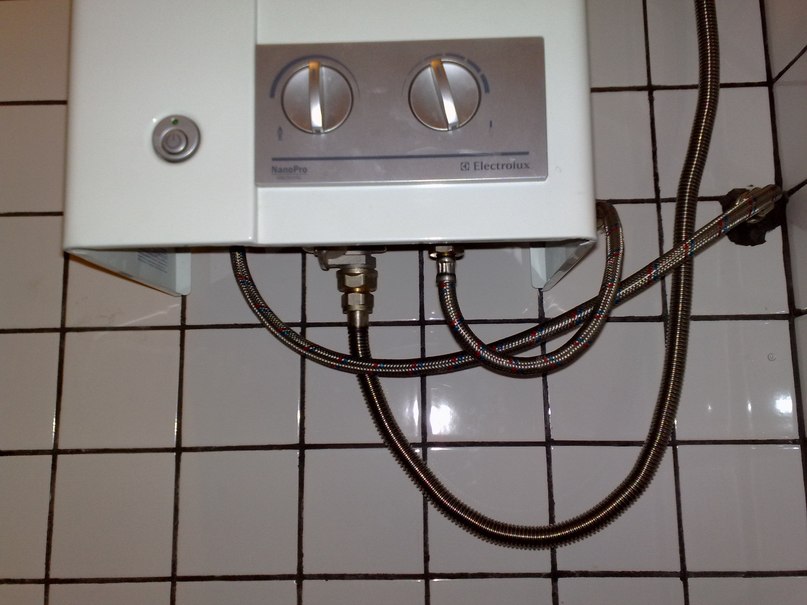
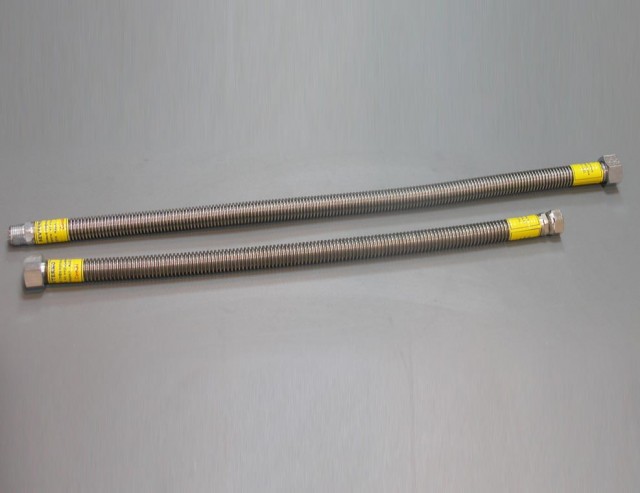
Application
The gas hose should have a slight slack. Therefore, you need to clearly define the length. The length must be determined based on the laying conditions. And the distance from the junction with gas pipe before entering the column. It is necessary to pay attention to the thread, which is located on this input. The tip of the connector must also match the diameter. If the diameters are different, you need to use a special adapter.
It should be borne in mind that the maximum length of such a hose will be 4.5 meters. Strong tension is not permitted. This can lead to deformation and, as a consequence, lead to the possibility of leakage. A small margin will allow you to move the stove slightly, in case of repair or wet cleaning.
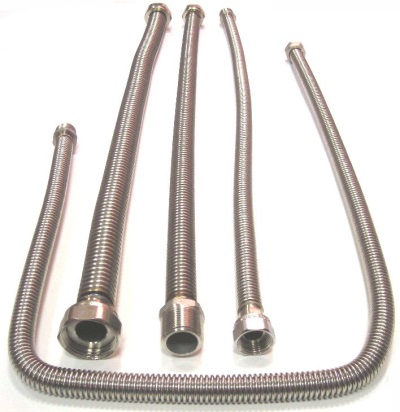
The gas hose is marked yellow. The water hose is red or blue.
Here is a small list of pipes that shops offer for connecting gas equipment. But, remember, you only need to use specialized gas hoses. And never use water hoses.
- Reinforced rubber hose. A budget option. It has good dielectric properties. True, the disadvantage of such a product is that it is subject to rapid destruction and the appearance of cracks.
- Metal braided rubber hose. Unlike its previous brother, it is resistant to mechanical damage. But, thanks to the braid, it is impossible to inspect the gas pipe and if it is defective, the leak cannot be found. Also the lack of a dielectric will be a disadvantage.
- Metal bellows hose. Durable, reliable, able to stretch and hold the desired angle. There are also disadvantages. High price compared to rubber hoses. There is also no dielectric. But, the most significant disadvantage is the possibility of burning holes in such a wiring. If the dielectric insert is not installed.
In any case, it is useful to ask the seller for a recommendation. Based on their experience, they will advise you on the best option. Do not purchase a product of dubious production. Follow these guidelines and the installation will go smoothly.








